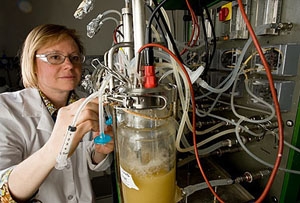
Most vehicles on the road today run on gasoline and diesel fuels, which are produced from oil—a non-renewable resource, meaning supplies are limited. Renewable resources, in contrast, are constantly replenished and are unlikely to run out. Biomass is one type of renewable resource that can be converted into liquid fuels (biofuels) for transportation. Biofuels include cellulosic ethanol, biodiesel, and renewable hydrocarbon (gasoline, diesel, and jet) fuels. The two most common types of biofuels in use today are ethanol and biodiesel. Biofuels can be used in most vehicles that are on the roads, unlike some other renewable alternatives that would require replacement of our current vehicle fleet.
Ethanol
Ethanol is an alcohol used as a blending agent with gasoline to increase octane and cut down carbon monoxide and other smog-causing emissions. The most common blend of ethanol is E10 (10% ethanol, 90% gasoline). Some vehicles, called Flexible Fuel Vehicles, are designed to run on E85, an alternative fuel with much higher ethanol content than regular gasoline. Roughly 97% of gasoline in the U.S. contains some ethanol.
Today, most ethanol is made from starches and sugars, but scientists are continuing to develop technologies that would allow for the use of cellulose and hemicellulose, the non-edible fibrous material that constitutes the bulk of plant matter. In fact, several commercial scale cellulosic ethanol biorefineries are currently operational in the U.S. The common method for converting biomass into ethanol is called fermentation. During fermentation, microorganisms (e.g., bacteria and yeast) metabolize sugar and produce ethanol as a waste product.
Learn more about ethanol basics.
Biodiesel
Biodiesel is made by combining alcohol with vegetable oil, animal fat, or recycled cooking grease. It can be used as an additive (typically 20%) to reduce vehicle emissions or in its pure form as a renewable alternative fuel for diesel engines.
Learn more about biodiesel basics.
Renewable Hydrocarbon "Drop In" Fuels
Petroleum fuels, such as gasoline, diesel, and jet fuel contain a complex mixture of hydrocarbons (molecules of hydrogen and carbon), which are burned to produce energy. Hydrocarbons can also be produced from biomass sources through a variety of biological and thermochemical processes.
Biomass based renewable hydrocarbon fuels are nearly identical to the petroleum-based fuels they are designed to replace—so they're compatible with today's engines, pumps, and other infrastructure. Currently, commercial-scale production of renewable hydrocarbon biofuels in the United States is in the demonstration and pilot stage.
Biofuel Conversion Processes
Biomass can be converted to liquid or gaseous biofuels using a variety of thermal, biological and chemical processes. Learn more about biofuels conversion processes.


